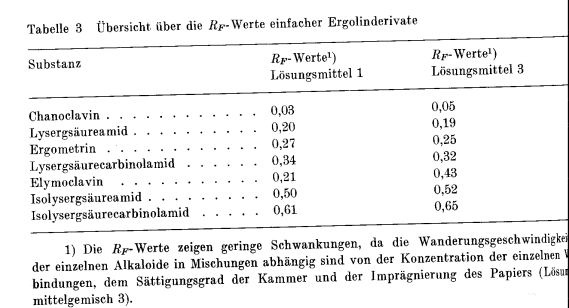Would somebody be able to translate this paper for us?
Well I could try, but it will take some time, and it will most likely not meet scientific standards.
I have no background in chemistry, and English is not my first language.
If that doesn't bothers you, I'll do it.
I will try to do at least one page a day, if life doesn't get in the way
(wow it rhymes)
If something doesn't make any sense, please say so, it might be due to my translation, and I could try to figure it out.
If the quality is so poor, the whole thing is basically useless, please say so too.
Otherwise it's a waste of time.
Ok I start with only a few sentences for now, I have other things to do first, but I'll be back in a few hours and finish the first page:
Presence of Ergoline derivatives in members of the Ipomea genus
Until lately derivatives of Ergoline where only found in sclerotia and saprophytic cultures of several members of the Claviceps genus.
In 1961
Spilsbury and
Wilkinson discovered the ability of fungi unrelated to Clavicipetaceae, to produce Clavinale alkaloids as well.
Even more surprising is the confirmation of Ergot alkaloids in several vascular plants,
Hofmann and
Tscherter (1960).
Both were able to isolate ergoline derivatives from “Ololiuqui”, a magic plant used by Aztec shamans.
It's use got already documented by spanish analist as early as the 16th century.
Today it still can be found used in magic rituals by some tribes of south Mexico(
Hofman 1961,
Hofman und
Cerletti 1961).
Ololiuqui is not of consistent botany.
Hofman examined 2 samples.
One consisted of brown seeds, called “badoh” by the native people, and was identified as
Rivea corymbosa (Hall. f. =Ipomea sidaefolia HBK).
The second sample consisted of black seeds, called “badoh negro” by the native people.
This was identified as
Ipomea violacea L..
Rivery corymbosa consisted of 0,01% alkaloids, and
Ipomea violacea consisted of 0,05% alkaloids.
The spectrum of present alkaloids proved to be almost identical for both samples.
Aside from chanoclavine and elymoclavine d-lysergic acid amide and d-isolysergic acid amide were isolated as main components.
Rivea corymbosa furthermore contained lysergol.Whereas
Ipomea violacea contained an alkaloid that couldn't be identified and which was fluorescent under UV-light.
According to
Taber and
Heacock (1962) the alkaloids are located in the embryo, whereas the husk and the resinous layer beneath are free of alkaloids.
Until now only 2 members of the Ipomoea family , both of Central American origin, have been tested for their alkaloid makeup.
Further research is needed to verify if other members of this genus produce alkaloids too.
It is not known if aside from the seeds other parts of the Ipomoea plants contain alkaloids as well.
The mechanism of production and biosynthesis of Ergoline in vascular plants is unknown to date. Further research will find the answers.
Own studies
The seed material used to carry out our studies was acquired from several botanical gardens in Europe.
The samples listed in the first table contained no alkaloids. The second table lists all alkaloid containing samples.
Samples with no alkaloids
0.5g of seed material was usually taken for analysis. Alkaloid extraction of the seeds and aerial parts of the plant was carried out using a variety of methods.
Most of the times we used a mixture of acetone/tartaric acid. For identification of the alkaloid mix methods of thin layer chromatography and paper chromatography were performed.
Adsorbing materials used include silica gel G”Merck”, soviet silicic acid and Al
2O
3 ”Greiz-Dölau”
(I have no idea how to translate Greiz-Dölau, it might just be the manufacturer, and also I have no clue how I'm supposed to do lower case letters and numbers, sorry)
In Figure 1 and 2 a typical chromatogram is shown. The analysis of a sample from Porto(Portugal)
produced 5 under UV-light fluorescent spots on the plate(silica gel, solvent: acetone, ethyl acetate, dimethyl formamide=5:5:1).
Application of Van Urk reagent caused a violet blue coloration of the spots.
One spot , with an R
F value of 0.03, and which was non-fluorescent under UV-light became violet blue as well.
The spots got labeled A-F(figure 1). The intensity of their coloration led to the conclusion substances B, C , D present the main components.
Substance A: Substance A had the same R
F-value like chromatographed chanoclavine.
For further identification it was scraped of the plate, eluted and in several systems chromatograms were generated with chanoclavine on the same plate.
This resulted in one spot respectively.
Figure 1
Thin layer chromatogram made from seed extract of Ipomoea rubro-caerulae Hook.
(adsorbent silica gel G "Merck"; developed using solvent mixture 1).
Figure 2
Thin layer chromatogram made from seed extract of Ipomoea coccinea Linn.
(adsorbent Al2O3 "Greiz-Dölau"; developed using solvent mixture 2).
Table 2: Alkaloid containing Ipomoea varieties
Edit:Can someone who is familiar with this stuff please verify if this makes sense so far?





